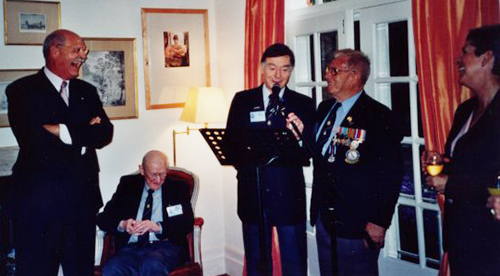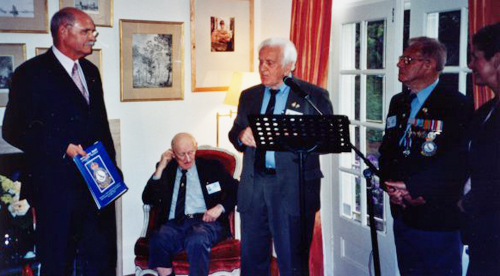
Bob Addison speaking at the Dutch Embassy
Dutch Embasy, Wednesday 3rd December, 2003
Air Commodore Tony Olstin, (Repr Chief of the RAAF Air Marshal, Angus Houston
Major General Adrian Clunes Ross, Chairman Australian War Memorial,
Mr Laurie Woods, President 460 squadron assoc. Queensland Branch,
Ladies & Gentlemen,
My wife Els and I are very happy to have you here today in our house. I was nearly four years old when World War 2 ended but I do have only a few memories of that war. One day living in Utrecht I was taken by my mother, with my sisters and other brother, up to the highest floor in the house. She opened the windows because she said we were going to see something extra–ordinary and exciting. I can tell you because my mother was so fascinated by the planes that were flying low and coming in that I had a chance to climb on the roof, a chance my parents would otherwise not have given me. But I recall, what had happened and what I had watched, was a food drop as part of the operation "Manna".
You all know that another operation called "Market Garden" in September 1944 had failed, or at least partially failed, but it had left a large part of the Dutch population facing another Winter under German occupation. That Winter became known as the Hunger Winter. Food rations were down, provision of food was irregular, it was a bitter cold Winter, and we had no coals. At home we would eat nettles. The chief problem area at that time was the densely populated West of the country with approx. 4 million people. They risked death by starving. Operation "manna" was the allied answer to that critical situation and operation "MANNA" was performed by the RAF. On the 29th April, 1945, 242 Lancasters flew that day to six drop zones in Holland and together they dropped 535 tons of food, dried peas, tinned bacon, tinned cheese, tea and not to forget chocolates.
The German flak remained quiet because that was part of the negotiations that was going on to secure the peace. The U.S. Air Force joined on the 1st May 1945, and their operation was called "Chowhound" "Manna" lasted ten days and stopped on the 8th May, 1945, three days after the Netherlands was liberated on the 5th May. Lasting over ten days the RAF dropped over 7,000 tons of food and the U.S. Air Force over 4,000 tons of food The aircraft involved the numbers were staggering. 3181 RAF aircraft were involved in those ten days, that means approx. 300 per day were flying over the Nederlands to drop food. Of those 3181 aircraft 3054 were Lancasters. 2210 U.S. aircraft operated in operation "Chowhound"
460 Squadron participated heavily in operation "Manna", it belonged to 1 Group and it operated from airfields between the Humber River and the City of Lincoln. When I learned about the reunion of 460 squadron and the reinstatement at the Australian War Memorial of "G" for George I had no hesitation to comply with Laurie Woods request to host a function. I wanted to use that occasion to pay tribute and thank crew members of 460 squadron, but also the Australians in other RAF squadrons, the navigators, the flight engineers, the bomber aimers who this time did not aim with bombs but aimed with food, and the wireless operators.
Ladies and Gentlemen it is really an honour and for me its a full circle almost to have you here today, to be able to thank you for what you did for my people and for my country and I hope you are going to enjoy this luncheon. Take it as a very small token of appreciation. Thank you very much.

Mr Laurie Woods then responded
Your Excellency Dr Hans Sondaal,
Major General Clunes Ross
Distinguished 460 squadron people, Ladies and Gentlemen, It was my thought originally of the desperation of the people in Holland when so many of them were starving to death and the fact that 460 squadron was so heavily involved in the "Manna" drop that we should possibly make contact with the Dutch people here in Australia and see what we could work out. Following a meeting in Brisbane, I found him to be a delightful person, and he said, "Oh yes, that is very good. Now I was four year old and the first time my parent allowed me to climb on the roof of our house and wave to the Lancasters, yes I'm sure we could arrange to have a luncheon, a sort of thank you "Manna". I later looked up the record and I found that a young fellow, who didn't even have a driving licence in Australia, by the name of Bob Addison, at 16.15pm on the 29th April, 1945 was the first of 460 squadron Lancaster pilots flying over Holland to drop the food and so we are here today. "Bob Addison, would you come forward please".
A short pause while Bob was found then "Here he is Bob Addison, meet Dr Hans Sondaal, he waved to you as you flew over at 16.15pm on the 29th April, 1945.
"Dr Sondaal jokingly remarked, "I recognise you now". "Would you like to say a few words Bob"
"Thank you Laurie I'm not sure you have your facts right". "Yes, I am Bob".
Bob Addison went on to say "When we got to the drop zone there were Lancasters right, left, and centre, and we were very pleased to be there, because young as we were, only 19, and well fed as we were, we knew the Dutch people were in a very desperate situation, and the food drop gave us a great deal of joy. Many members of the crews who had access to a gun turret, would send down bars of chocolate on parachutes, made out of handkerchiefs. Very little design skills in the parachutes and I imagine the chocolates hit the ground pretty hard". "I went over three times, I remember the pleasure in delivering the food to these hungry people, but there was always the humorous side. It was one of the funniest sights I have ever seen to see another Lancaster right beside us, with the bomb doors suddenly open up and these far from air worthy packages would come tumbling out in all directions. A lot of aircraft came back with severe bruising on the tailplanes and rudders. There were some bursting on the ground of bags of flour and tomato sauce". Dr Hans "We didn't mind scraping them up".

"One of our fellows Peter Mason was full of good spirits, diving in at a steep angle and then he levelled out, the "G" force was too much for the load and it went through a lot of roofs". Remark from the side Aussie humour "Home delivery"
Keith Chamberlain, who flew three "Manna" drops then carried on, "We knew the Dutch people were in dire straits. Many crews had mixed feelings approaching the drop zones, knowing the Germans had many anti aircraft guns deployed around the drop zones. A few Lancasters returned with bullet holes from small arms fire, while one U.S. B17 was shot down and only three crew members surviving.
Mention must be made of the arduous task of the ground crews in loading the sacks of food in the bomb bays for free fall. Each plane took up to three tons of food and took three hours to load. The hydraulics operating the bomb doors depended on power from the motors running. In loading they had to partially open the bomb bay doors, climb in and then as the packages were physically passed up to them they had to stack them in the bomb bay. Pieces of timber were used to hold the bomb doors in place for loading, until the motors were started ready for take off, then the bomb doors could be closed hydraulically". Thank you Keith.
"And now Dr Sondaal, Your Excellency and your lovely wife, we thank you very much for having us. We know the food drop "Manna" was of wonderful assistance to the Dutch people, it saved a lot of lives and enabled you to come here and charm us". Dr Sondaal, "It saved my brother, he was a bit thin"
"Your Excellency we have John Currie from Western Australia who flew four "Manna" drops".
John Currie then explained how he had prepared a complete and comprehensive history of the "Manna" drops especially for this visit and he was very pleased to present it to His Excellency. The presentation booklet was a very professional publication, beautifully set out in colour, complete with the 460 squadron crest on the front cover.
Dr Sondaal thanked John for his work and expressed appreciation of the time and effort which must have gone into the preparation and printing of such a publication.
"Thank you so much John"..